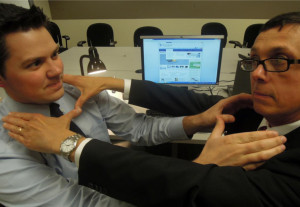Conflict can arise if management does not support user experience
I have two tales of trying to sell the benefits of user experience (UX) in a company. In one case I succeded, and in the other I failed.
Building out a user experience team and making user experience relevant companywide assume there is buy-in from management. I’ve found these key points helpful:
- Evangelizing UX to company executives is overrated
- Understanding business objectives is where UX starts
- Getting the UX message out requires involving management in the process
Evangelizing for and Selling the Idea of User Experience
Perhaps “evangelizing” is the wrong word here, in that we as UX professionals are not trying to “convert” colleagues, stakeholders, and executives to have faith and trust in user experience. However, I would argue that we need to have a company champion or executive-level buy-in to succeed. What happens if you don’t have that champion or executive-level buy in? Then you’re probably working in the wrong company.
I learned this valuable lesson awhile back in a previous company I was employed at. I worked on getting usability testing into the product development cycle through a series of small steps: getting buy in from my boss; doing an expert review; doing paper prototyping; and running usability tests with a small number of internal employees and reporting back to the team on the issues we found.
The product eventually went on to win an award, but before it did I got called into the president’s office. The president told me, “”We don’t need usability here. Go help the sales people sell our product.” I was completely dumbstruck, and maybe a little naive.
The main lesson I learned was, if management doesn’t support UX within the company, then get out of that company. And I did.
Demonstrating the Value of UX and Making a Case for More UX Practitioners
Now turning to a success story. One thing that I value most about my current company is I haven’t had to evangelize user experience to senior management. They believe in putting products in front of users. When I started, I was a UX department of one but have been able to hire an average of 1 UX professional a year by making a case for usability.
I followed these key points:
1. Get to know your key stakeholders and understand their business objectives.
We make a point of meeting with stakeholders, annually, quarterly, and on a project-by-project basis to understand what the high-level goals and business objectives of each project are. If we understand the business owners’ strategy, then we can build a UX strategy around it. By identifying the problem areas and issues, we can forward with the right UX methodology. Our UX research team has been successful by working shoulder to shoulder with our stakeholders. We involve the business team in the UX process. For us UX researchers, this means collaborating with them on the UX methodology chosen, the participant recruiting screener, and the usability test plan. And we keep revisiting the business objectives at every stage of product development, because sometimes people forget
2. Show, don’t tell
After we run usability tests, we try to make video clips where we present results, showing positives but also showing users struggling with our products. As UX professionals we can make whatever points we want, but it doesn’t mean people will believe us. But you can’t argue with users.
3. When you have usability readouts and meetings, bring food
At some meetings, we bring in lunch. At others we’ll bring all sorts of snacks. We don’t try to economize on this. We’ll buy the good pizza.
4. Get the message out by involving people in the company
A lot of people don’t know what USER EXPERIENCE is.
So I’ve been able to sell the benefits of user experience in different ways. One way is to do lunch and learn presentations, where I demonstrate the usability research and testing work we do. I’ve done a few of these in different departments of the organization, and as a result we have more people asking for our services.
A second way has been, of course, to invite stakeholders and management to usability tests. In some companies I’ve worked for, the key stakeholders don’t come to observe; in others, they do. But they all pay attention to what participants have to say in the video clips.
A third way has been to include stakeholders and management in practice runs of usability tests and in paper prototyping sessions. People like it when you ask them to get involved, and this way they can find out what user experience is first hand.
Conclusion
So this is a case where things went well. But it all began because we were working in a company culture that was willing to embrace user experience.
